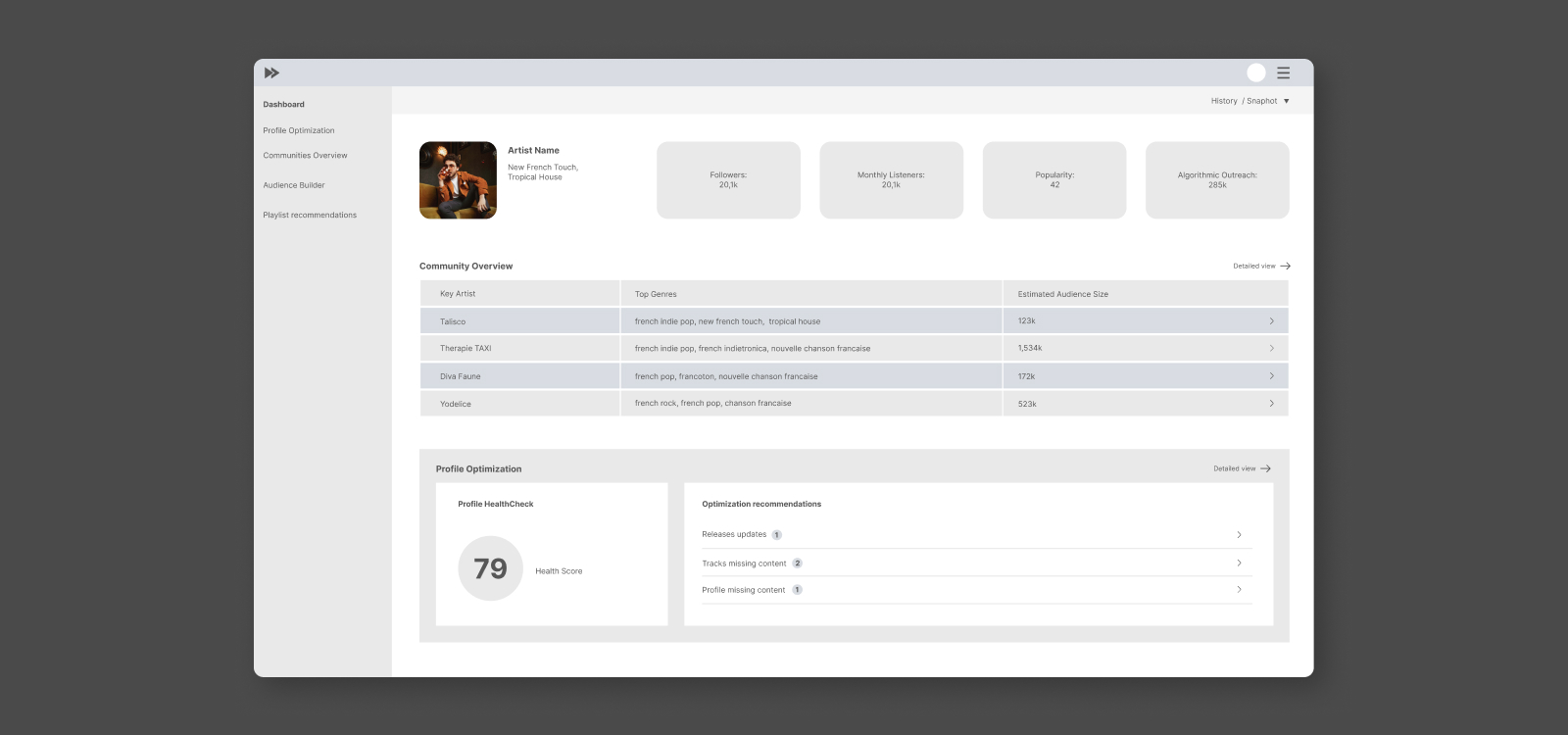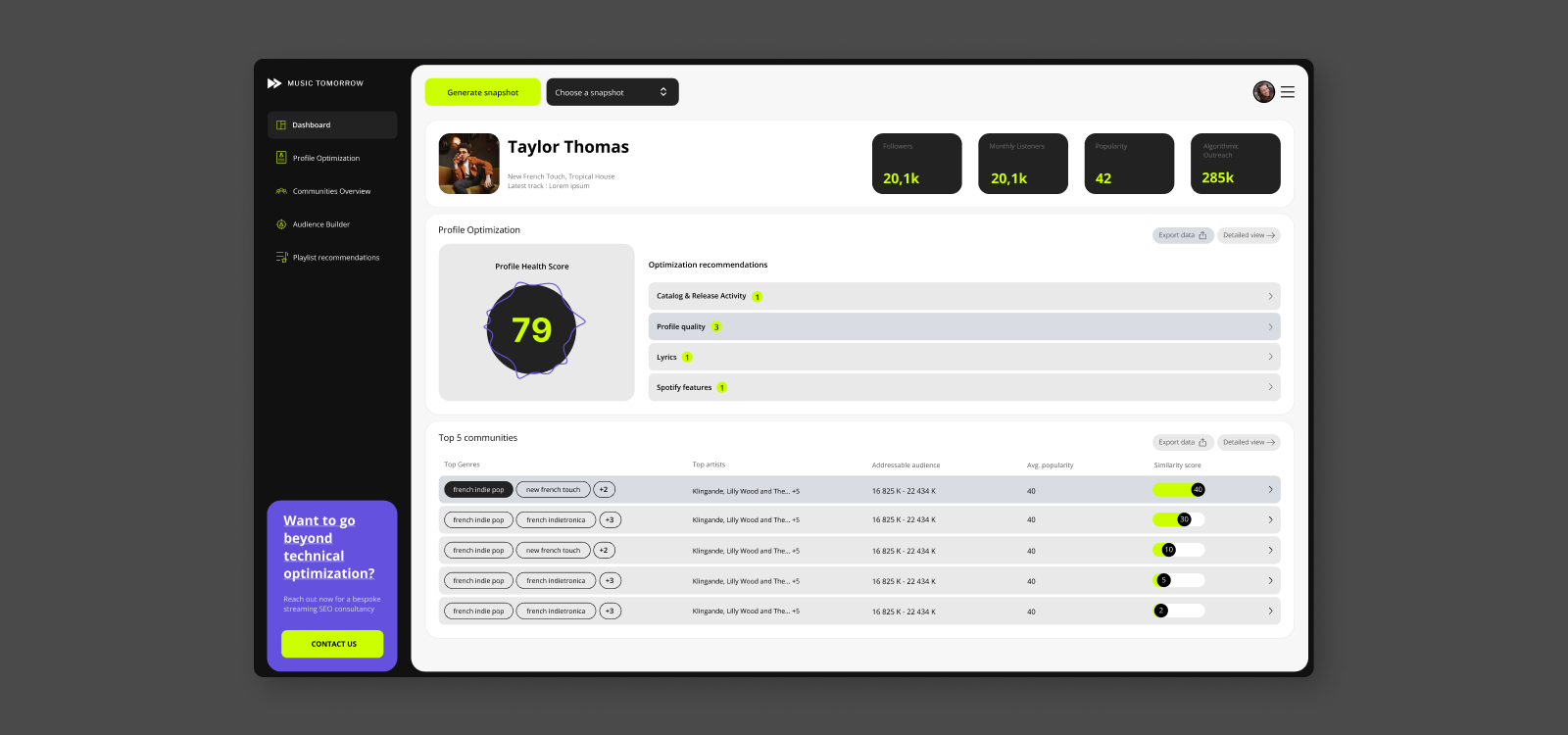Music Tomorrow
Streaming SEO Analysis Platform for Music Artists
Overview
Empowering artists and labels to unlock streaming success with SEO.
Music Tomorrow provides a SaaS platform designed to help artists and labels analyze and optimize their performance on streaming platforms. Much like traditional SEO tools enhance visibility on search engines, Music Tomorrow’s solution delivers actionable insights into playlists, audience engagement, and streaming algorithms. By turning complex data into intuitive visualizations and tailored recommendations, the platform enables users to refine their profiles, improve their reach, and boost their listener base effectively.
Team
- 1 PM
- 1 data engineer
- 2 devs
- 1 Ui designer
Services
- Branding
- Product design
- Design system
Duration
Jan 2022–Current
Client request
MT asked me to design a platform to emphasize the need for transparency in how algorithms work, providing users with a deeper understanding of the factors driving their visibility. Additionally, they wanted the platform to highlight concrete actions to optimize profiles, and intuitive data visualizations to represent complex metrics.
My Role
I began by conducting user research, including interviews and co-creation workshops. I designed intuitive user journeys, proposed key features, and ensured fluid navigation to simplify complex data.
As part of this process, I guided the reflection on graph strategies. My work focused on making complex industry data more understandable, leveraging visual storytelling techniques to enhance decision-making.
Then I led a complete rebranding of Music Tomorrow, establishing a cohesive visual identity that reflected the platform’s innovative and data-driven mission.
Collaborating closely with the R&D team, I contributed to the development of a new SaaS platform, and I continue to support the product’s evolution, ensuring it remains user-centered and aligned with industry trends.


Context
Navigating Modern Music Promotion
Promoting music has become increasingly complex. Artists must navigate a fragmented ecosystem of streaming platforms (Spotify, YouTube, Deezer) and social media channels (TikTok, Instagram), making it nearly impossible to measure the true impact of their actions on their success.
Traditional PR campaigns can cost €10k with no guaranteed results, while streaming revenues remain low, paying as little as €0.003 per stream. Playlists, however, remain a critical driver of visibility, accounting for over 30% of streams on platforms like Spotify. Yet, for many, understanding how to get featured remains a mystery.
This is where Music Tomorrow steps in with its platform, designed to bring clarity and control to this fragmented landscape.

Laying the Foundation
The initial request was to create a quick prototype organized around two core features.
The first focused on profile optimization. The information about the artist, their tracks metadata is a fundamental element in enabling streaming algorithms to accurately categorize music. By retrieving data from the platform ID, the system could analyze their completeness and determine their impact on performance.
The second feature centered on identifying the most relevant playlists for the artist. By comparing the style of tracks, similar artists, and the musical microcosm, along with assessing the listener potential and reach of playlists, the tool aimed to define strategies tailored to each artist.
However, after conducting initial tests on our panel, it became clear that the prototype only partially addressed user needs. While maintaining a simple interface was a deliberate design strategy, feedback from the initial panel of independent artists and labels highlighted a significant demand for more detailed insights.
It was time to dive deeper into user research!


Research
Decoding music market users’ needs
To better align the product with user needs, we needed to understand the behaviors, motivations, needs, and frustrations of our target audience. Leveraging Music Tomorrow’s existing community—built through their consulting work and musictech media presence—we accessed a pool of engaged newsletter subscribers, including artists and labels, making it straightforward to recruit interviewees for the study.
We structured our research around two main goals:
- Understanding user knowledge of streaming algorithms and platform mechanics: We aimed to assess how well artists and labels understood the technical aspects of streaming platforms and their impact on visibility.
- Identifying the KPIs that matter most to them: Our goal was to uncover the key metrics users consider critical to defining and measuring their success.
Key learnings
- Provide clear insights on playlists, marketing and collaborations
- Focus on key KPIs: highlight track performance, stream sources, and playlist growth
- Enable benchmarking: include tools to compare performance with peers or competitors
- Build trust: ensure transparency in data collection and metric calculations to increase confidence in the platform
Define
Meet our users
From the conversations we had, we spotted two common personas that represent the shared experiences and needs of our interviewees. They highlighted the contrasting levels of knowledge and distinct needs between artists, who required simplified guidance and actionable insights, and independant labels, who needed robust tools for managing multiple profiles, enabling us to design a platform that effectively addressed both user groups’ challenges.
How might we crack the recommender systems?
Following our user research, we needed to frame the insights into concrete solutions.
With challenges such as better marketing strategy management, tracking critical KPIs, and optimizing opportunities, we needed to understand how to gain mastery over algorithmic recommendations. To achieve this, we organized a series of ideation workshops.
We first used the “How Might We” methodology to reframe these challenges into opportunities.
Mapping Discoverability
Building on the outcomes of this exercise, we then narrowed our focus to the area with the highest impact: optimizing artist discoverability. To address this, we created a detailed map of the processes involved in enhancing discoverability and increasing streams, allowing us to better understand the mechanisms and opportunities.
This work was conducted in close collaboration with the technical teams to ensure solutions were not only user-centered but also achievable within the platform’s technical capabilities.
Building on the outcomes of the HMW, we then narrowed our focus to the area with the highest impact: optimizing artist discoverability by mapping the processes involved. Collaborating with technical teams, we ensured the solutions were both user-centered and feasible within the constraints of the data.
Design stages
Wireframes
With a clear understanding of the platform’s functionalities and their hierarchy, I began by creating wireframes that prioritized delivering the most essential information in a clear and accessible format. The design emphasized key elements such as highlighting critical data at a glance, providing actionable insights to help users optimize their performance, and visualizing artist communities to showcase how algorithms interpret their musical universe.
Some sections, such as data visualizations, required close collaboration with the R&D team to ensure they were both clear and strategically impactful.
Prototypes were tested iteratively with artists and labels, leading to refinements that emphasized data and metrics clarity by demonstrating how calculations were performed and detailing the data sources.


Design direction
Based on the wireframe blueprint, this was an opportunity to refresh Music Tomorrow’s identity. The branding was revamped to feel more modern, blending the aesthetics of SaaS interfaces with the dynamic elements of streaming platforms. It was also the occasion to create a cohesive series of illustrations used across all physical and digital communication materials.
The design process for the new Music Tomorrow experience took place over several weeks. It involved multiple iterations, including tailored dashboard versions based on user subscription types, and continuous feedback from both the team and users to refine the experience.
I developed an initial visual concept to showcase the new identity across various layouts before finalizing the UI for all screens. To ensure a seamless transition to development, I provided a comprehensive design kit with style guides and assets.




Conclusion
Results
Since the plateform’s launch, Music Tomorrow has grown from 0 to €154K ARR without funding, establishing itself as the first analytics solution dedicated to algorithmic performance. Today, the platform supports 30 labels, including Universal, Because Music, Warner Music Group, and Infiné, empowering 150 artists globally to optimize their streaming strategies.
Takeaways
This project reinforced the importance of making data truly actionable—raw metrics aren’t enough; clarity and usability drive real impact. User research was essential in uncovering the real needs of artists and labels, shaping a platform that simplifies algorithm understanding and discoverability strategies. Additionally, data visualization proved to be a powerful tool, helping users grasp insights quickly to make their strategic decisions.
Looking Forward
Our next challenge at Music Tomorrow will push the boundaries of AI-driven insights to provide personalized growth strategies for artists and labels. Predictive analytics will help users anticipate trends, while a peer network feature will unlock new collaboration opportunities by connecting artists within relevant musical ecosystems.
As the industry evolves, the platform will continue to adapt and innovate, ensuring it remains an essential tool for navigating the complexities of streaming success.

Previous project
Gouny & Starkley
Next project



